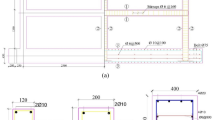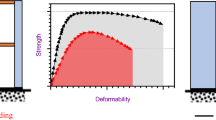Abstract
A mainshock is usually accompanied by a group of ground motions. In many design codes, the effects of the seismic sequences have been neglected or underestimated. Aftershocks can increase structural damage or even cause failure. The current study evaluated the seismic behavior of a rehabilitated and as-built reinforced concrete (RC) structure under real scaled mainshock-aftershocks using nonlinear analysis. Verification was done in three modes. The inter-story drift ratio, maximum residual, and relative displacements were studied. The seismic study of the as-built structure showed that the residual displacement grew, on average, more than 78% under the mainshock-aftershock sequence compared to the mainshock-only record. A beam-column bonded Carbon-fiber-reinforced polymers (CFRP) rehabilitation strategy using six layers of T-700 CFRP was chosen based on the specific performance level. The strategy showed the ability to transfer the plastic strain from the columns to the beams, which could be considered as a change from a weak column-strong beam concept to a strong column-weak beam concept. Compared to the as-built structure under the seismic sequences, the rehabilitated structure showed an average growth of − 81% in the first-story drift ratio, which was significant. Unlike the as-built structure, seismic sequences caused no growth drift in the rehabilitated structure. It also was observed that the ratio of aftershock peek ground acceleration (PGA) to mainshock PGA could have an intensive effect on the seismic behavior of both rehabilitated and as-built structures.





















Similar content being viewed by others
References
Ahmadi M (2013) Analysis of rehabilitation effect on the improvement capacity of reinforced concrete beams with FEM. Procedia Eng 54:327–340
Amadio C, Fragiacomo M, Rajgelj S (2003) The effects of repeated earthquake ground motions on the non-linear response of SDOF systems. Earthquake Eng Struct Dynam 32–2:291–308. https://doi.org/10.1002/eqe.225
American Concrete Institute (ACI) (2008) Guide for the design and construction of externally bonded FRP systems for strengthening concrete structures. ACI, Farmington Hills
Beer FP, Johnston R, Dewolf J, Mazurek D (2013) Mechanics of materials. McGraw-Hill, New York
Cabral-Fonseca S, Correia JR, Custódio J, Silva HM, Machado AM, Sousa J (2018) Durability of FRP-concrete bonded joints in structural rehabilitation: a review. Int J Adhes Adhes 83:153–167. https://doi.org/10.1016/j.ijadhadh.2018.02.014
Calvi GM, Magenes G, Pampanin S (2002) Relevance of beam-column joint damage and collapse in RC frame assessment. J Earthquake Eng 6–01:75–100. https://doi.org/10.1080/13632460209350433
Carreira DJ, Chu KH (1986) Stress-strain relationship for reinforced concrete in tension. J Proc 83–1:21–28
Centeno J (2009) In-plane shake table testing of gravity load designed reinforced concrete frames with unreinforced masonry infill walls (Doctoral dissertation, University of British Columbia)
Chajlani J, Hussain A (2015) Application of FRP in concrete structures. Int J Eng Assoc 4–8:50–51
Chopra AK (2007) Dynamics of structures. Pearson Education India, London
Dassault Systèmes (2017) Getting start with ABAQUS tutorial. ABAQUS Version 6.14. Dassault Systèmes, Providence
Dazio A, Bachmann H (2000) State of the seismic design and detailing of buildings with RC structural walls in Europe. In: Proceeding of the 12th world conference on earthquake engineering. No. 526.
Del Rey CE, Griffith M, Ingham J (2018) Seismic behavior of RC columns flexurally strengthened with FRP sheets and FRP anchors. Compos Struct 203:382–395. https://doi.org/10.1016/j.compstruct.2018.07.029
Di Sarno L (2013) Effects of multiple earthquakes on inelastic structural response. Eng Struct 56:673–681. https://doi.org/10.1016/j.engstruct.2013.05.041
El-Sokkary H, Galal K (2009) Analytical investigation of the seismic performance of RC frames rehabilitated using different rehabilitation techniques. Eng Struct 31–9:1955–1966. https://doi.org/10.1016/j.engstruct.2009.02.048
Federal Emergency Management Agency (2000) Commentary for the seismic rehabilitation of buildings (FEMA356). Prestandard FEMA, Washington
FIB Task Group 9.3 (2001) Externally bonded FRP reinforcement for RC structures, Technical Report. Fib Bulletin 14, CEB-FIP, Lausanne, Switzerland.
Ghobarah A, Abou Elfath H (2001) Rehabilitation of a reinforced concrete frame using eccentric steel bracing. Eng Struct 23–7:745–755. https://doi.org/10.1016/S0141-0296(00)00100-0
Ghobarah A, Said A (2001) Seismic rehabilitation of beam-column joints using FRP laminates. J Earthquake Eng 5–01:113–129. https://doi.org/10.1080/13632460109350388
Grazide C, Ferrier E, Michel L (2020) Rehabilitation of reinforced concrete structures using FRP and wood. Constr Build Mater 234:117716. https://doi.org/10.1016/j.conbuildmat.2019.117716
Hainzl S, Steacy S, Marsan D (2010) Seismicity models based on Coulomb stress calculations. Report, Community Online Resource for Statistical Seismicity Analysis. https://doi.org/10.5078/corssa-32035809. http://www.corssa.org.
Hassan SA, Santulli C, Yahya MYB, Gang CL, Abu BMN (2018) The potential of biomimetics design in the development of impact resistant material. FME Trans 46–1:108–116. https://doi.org/10.5937/fmet1801108H
Hassan T, Rizkalla S (2002) Flexural strengthening of prestressed bridge slabs with FRP systems. PCI J 47–1:76–93
Hatzivassiliou M, Hatzigeorgiou GD (2015) Seismic sequence effects on three-dimensional reinforced concrete buildings. Soil Dyn Earthq Eng 72:77–88. https://doi.org/10.1016/j.soildyn.2015.02.005
Hibbitt HD, Karlsson BI (1979) Analysis of pipe whip, Report No. EPRI-NP—1208. Hibbitt and Karlsson Inc.
Hilber HM, Hughes TJ, Taylor RL (1977) Improved numerical dissipation for time integration algorithms in structural dynamics. Earthquake Eng Struct Dyn 5–3:283–292. https://doi.org/10.1002/eqe.4290050306
Hollaway LC (2014) Using fibre-reinforced polymer (FRP) composites to rehabilitate differing types of metallic infrastructure. Rehabilitation of metallic civil infrastructure using fiber reinforced polymer (FRP) composites. Woodhead Publishing, Cambridge, pp 323–372
Isis Canada (2001) Strengthening reinforced concrete structures with externally-bonded fibre reinforced polymers. ISIS Canada
İşleyen ÜK, Ghoroubi R, Mercimek Ö, Anıl Ö, Togay A, Erdem RT (2021) Effect of anchorage number and CFRP strips length on behavior of strengthened glulam timber beam for flexural loading. Adv Struct Eng. https://doi.org/10.1177/1369433220988622
Ji D, Wen W, Zhai C, Katsanos EI (2020) Maximum inelastic displacement of mainshock-damaged structures under succeeding aftershock. Soil Dyn Earthq Eng 136:106248. https://doi.org/10.1016/j.soildyn.2020.106248
Johnson S (2006) Comparison of nonlinear finite element modelling tools for structural concrete. University of Illinois, US, Urbana
Johnson GR, Cook WH (1985) Fracture characteristics of three metals subjected to various strains, strain rates, temperatures and pressures. Eng Fract Mech 21(1):31–48
Kurata M, Leon RT, DesRoches R, Nakashima M (2012) Steel plate shear wall with tension-bracing for seismic rehabilitation of steel frames. J Constr Steel Res 71:92–103. https://doi.org/10.1016/j.jcsr.2011.10.026
Lee J, Fenves GL (1998) Plastic-damage model for cyclic loading of concrete structures. J Eng Mech 124(8):892–900
Li Y, Song R, Van De Lindt JW (2014) Collapse fragility of steel structures subjected to earthquake mainshock-aftershock sequences. J Struct Eng 140–12:04014095. https://doi.org/10.1061/(ASCE)ST.1943-541X.0001019
Lie-ping YE, Qian-li MA, Zhi-wei MIAO (2010) Study on weak beam-strong column design method of RC frame structures. Eng Mech 2–12:102–113. https://doi.org/10.6052/j.issn.1000-4750.2009.05.0320
Lubliner J, Oliver J, Oller S, Onate E (1989) A plastic-damage model for concrete. Int J Solids Struct 25(3):299–326
Mander JB, Priestley MJ, Park R (1988) Theoretical stress-strain model for confined concrete. J Struct Eng 114–8:1804–1826. https://doi.org/10.1061/(ASCE)0733-9445(1988)114:8(1804)
Massumi A, Sadeghi K, Ghaedi H (2021) The effects of mainshock-aftershock in successive earthquakes on the response of RC moment-resisting frames considering the influence of the vertical seismic component. Ain Shams Eng J 12–1:393–405. https://doi.org/10.1016/j.asej.2020.04.005
Massumi A, Mahboubi B, Ameri MR (2015) Seismic response of RC frame structures strengthened by reinforced masonry infill panels. Earthquakes Struct. https://doi.org/10.12989/eas.2015.8.6.1435
Meitz J (1998) Electrochemical rehabilitation methods for reinforced concrete structures: a state of the art report. Europe: The Institute of Materials Minerals and Mining, Europe
Moustafa A, Takewaki I (2011) Response of nonlinear single-degree-of-freedom structures to random acceleration sequences. Eng Struct 33–4:1251–1258. https://doi.org/10.1016/j.engstruct.2011.01.002
Nakaba K, Kanakubo T, Furuta T, Yoshizawa H (2001) Bond behavior between fiber-reinforced polymer laminates and concrete. Struct J 98(3):359–367
Nazari N, Van De Lindt JW, Li Y (2015) Effect of mainshock-aftershock sequences on woodframe building damage fragilities. J Perform Constr Facil 29(1):04014036
Obaidat Y (2011) Structural retrofitting of concrete beams using FRP-debonding issues. Lund University, Lund
Pacific Earthquake Engineering Research Centre (2011) PEER ground motion database. https://ngawest2.berkeley.edu/.
Pampanin S, Bolognini D, Pavese A (2007) Performance-based seismic retrofit strategy for existing reinforced concrete frame systems using fiber-reinforced polymer composites. J Compos Constr 11(2):211–226
Pampanin S, Calvi GM, Moratti M (2002) Seismic behavior of RC beam-column joints designed for gravity only. University of Canterbury, London
Parry RH (2004) Mohr circles, stress paths and geotechnics. CRC Press, New York
R. D. (1939) Regio Decreto Leggne. XVIII, G.U. n. 2228 (in Italian).
Ramberg W, Osgood WR (1943) Description of stress-strain curves by three parameters. NACA-TN-902 National Advisory Committee for Aeronautics, Washington, DC
Rinaldin G, Amadio C (2018) Effects of seismic sequences on masonry structures. Eng Struct 166:227–239
Ruiz-García J (2012) Mainshock-aftershock ground motion features and their influence in building’s seismic response. J Earthquake Eng 16–5:719–737. https://doi.org/10.1080/13632469.2012.663154
Ruiz-García J, Negrete-Manriquez JC (2011) Evaluation of drift demands in existing steel frames under as-recorded far-field and near-fault mainshock–aftershock seismic sequences. Eng Struct 33:621–634. https://doi.org/10.1016/j.engstruct.2010.11.021
Savoia M, Ferracuti B, Mazzotti C (2003) Non linear bond-slip law for FRP-concrete interface. In: Savoia M (ed) Fibre-reinforced polymer reinforcement for concrete structures, vol 2. World Scientific Publishing Co. Inc., Hackensack, pp 163–172
Soureshjani OK, Massumi A (2022) Seismic behavior of RC moment resisting structures with concrete shear wall under mainshock–aftershock seismic sequences. Bull Earthquake Eng 20:1087–1114
Spence R, Lopes M, Bisch P, Plumier A, Dolce M (2005) Earthquake risk reduction in the European Union. In Proposal for a European earthquake risk reduction programme–a discussion document. European Association for Earthquake Engineering, following Lisbon Workshop.
Syrmakezis CA, Mavrouli OA, Antonopoulos AK (2006) Rehabilitation of hospital buildings using passive control systems. Smart Struct Syst 2–4:305–312. https://doi.org/10.12989/sss.2006.2.4.305
Tauheed A, Alam M, Datta TK (2022) Influence of mass irregularity on the response of RC frame with stiffness irregularity by non-linear time history analysis. In: Kolathayar S (ed) Recent advances in earthquake engineering. Springer, Singapore, pp 135–159
Toray Composite Materials America, Inc. (2020) Carbon fiber products T700. Tacoma, Washington
Venture SJ (2000) State of the art report on systems performance of steel moment frames subject to earthquake ground shaking. FEMA 355C
Wang G, Wang Y, Lu W, Yan P, Chen M (2018) Earthquake direction effects on seismic performance of concrete gravity dams to mainshock-aftershock sequences. J Earthquake Eng 24–7:1–22. https://doi.org/10.1080/13632469.2018.1453423
Wang QL, Li J, Shao YB, Zhao WJ (2016) Flexural performances of square concrete filled CFRP-steel tubes (S-CF-CFRP-ST). Adv Struct Eng 18–8:1319–1344. https://doi.org/10.1260/1369-4332.18.8.1319
Yang D, Pan J, Li G (2010) Interstory drift ratio of building structures subjected to near-fault ground motions based on generalized drift spectral analysis. Soil Dyn Earthq Eng 30–11:1182–1197. https://doi.org/10.1016/j.soildyn.2010.04.026
Acknowledgements
There is no acknowledgment.
Funding
This research was not funded by any funding bodies.
Author information
Authors and Affiliations
Corresponding author
Ethics declarations
Conflict of interest
The Authors declare that they have no conflict of interest.
Clinical trials registration
Not applicable.
Ethical approval
The developed method is the original effort of the authors which is not submitted or published elsewhere.
Gels and bolts/Image manipulation
Not applicable.
High-risk content
Not applicable.
Plant reproducibility
Not applicable.
Availability of data and material
Data and material are available.
Code availability
The developed codes are available.
Additional information
Publisher's Note
Springer Nature remains neutral with regard to jurisdictional claims in published maps and institutional affiliations.
Rights and permissions
About this article
Cite this article
Soureshjani, O.K., Nouri, G. Seismic assessment and rehabilitation of a RC structure under mainshock-aftershock seismic sequences using beam-column bonded CFRP strategy. Bull Earthquake Eng 20, 4989–5016 (2022). https://doi.org/10.1007/s10518-022-01382-3
Received:
Accepted:
Published:
Issue Date:
DOI: https://doi.org/10.1007/s10518-022-01382-3




